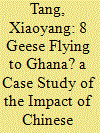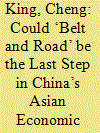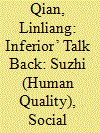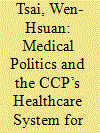|
|
|
Sort Order |
|
|
|
Items / Page
|
|
|
|
|
|
|
| Srl | Item |
| 1 |
ID:
161519


|
|
|
|
|
| Summary/Abstract |
China has significantly changed its engagement mode with Africa, shifting from trade of natural resources to investment in industrial sectors. This article uses Ghana as a case study to examine why and how Chinese investors come to set up factories in Africa’s challenging business environment. Through first-hand scoping study on the ground, the author reveals that the pressure of China’s industrial upgrading and the vast potential of Africa’s growing market are the main drives for Chinese manufacturers. Clustering and industrial zones proved to be effective instruments to help Chinese manufacturers grow in Ghana. The clustering of numerous small and medium-sized enterprises also facilitates linkage building between Chinese projects and the local economy. The ‘flying geese’ phenomenon is emerging in Ghana’s manufacturing sector, but the weak macro-economy and the lack of industrial supports largely slow down the progress of Chinese investments and reduce the spillover effects.
|
|
|
|
|
|
|
|
|
|
|
|
|
|
|
|
| 2 |
ID:
161516


|
|
|
|
|
| Summary/Abstract |
China has launched an international charm offensive in earnest since around 2004. This has consequentially stirred up expensive and intense debates over the effectiveness of China’s soft power and public diplomacy. Yet, to date, no one has investigated the change in public perceptions of China in any particular country since China’s launch of its public diplomacy. In this article, the authors scrutinize South Koreans’ evolving views of China between 2002 and 2017, decipher the factors that have influenced their views of China based on in-depth analysis of various surveys, and consider the relevant opinions of South Korean scholars and the public. The findings suggest that China’s charm offensive has not been effective during the past decade. Not only have South Koreans’ views on China’s global influence deteriorated between 2004 and 2017, but their favorable opinion of China has not improved over the same period. In terms of soft power, China has surpassed Japan since around 2013, yet still lags far behind the U.S. Given the characteristics of the negative factors related to ideological, emotional, and conflicting strategic interests, it is unlikely that we will see a positive trend in South Koreans’ views on China for some years ahead.
|
|
|
|
|
|
|
|
|
|
|
|
|
|
|
|
| 3 |
ID:
161518


|
|
|
|
|
| Summary/Abstract |
In recent years, five historic Chinese Communist revolutionary sites—Shanghai, Jinggangshan (Jiangxi province), Zunyi (Guizhou province), Yan’an (Shaanxi province) and Xibaibo (Hebei province)—have been labeled as the most sacred sites in the history of the Chinese Communist Party (CCP) by local officials in order to promote tourism and patriotic education among young people. This widely publicized state campaign has been undertaken in an era of reform driven by unbridled capitalistic market forces when Communist ideology is losing its magnetic pull. However, the official promotion of these old revolutionary sites reveals several sharp areas of tension in today’s China: ‘red tourism’ (exploiting the heritage of the CCP for the tourism industry) versus ‘green tourism’ (scenic sightseeing for personal gratification), Communist ideology versus a market economy, and state domination versus local autonomy.
|
|
|
|
|
|
|
|
|
|
|
|
|
|
|
|
| 4 |
ID:
161513


|
|
|
|
|
| Summary/Abstract |
This article assesses the role of China’s ‘Belt and Road’ initiative (BRI) in the country’s intended global economic integration. Particular attention is paid to China’s capital penetration of Asian markets, with an empirical assessment of the structure of Asian markets from the perspective of foreign trade, foreign direct investment (FDI) and intergovernmental aid. The success of China’s new opening-up initiative will be largely contingent on Asian markets’ recognition of Chinese products and capital: its trade with potential cooperative countries and its FDI and intergovernmental aid to them fall behind those of the developed countries that are China’s major cooperative partners in/outside Asia. China’s ongoing Asian economic strategy thus faces competition and will need to integrate the BRI into the current framework of international economic cooperation.
|
|
|
|
|
|
|
|
|
|
|
|
|
|
|
|
| 5 |
ID:
161515


|
|
|
|
|
| Summary/Abstract |
Using a mixed-methods approach, this article surveys and compares how Chinese youth view China’s rise with how their Asian counterparts do. The quantitative analysis uses data from the Asian Student Survey to identify the differences in perception of China’s rise between Chinese and Asian youth. Qualitative interviewing is undertaken to probe and assess the reasons behind the gap. The results show that Chinese youth are more optimistic about political stability and nationalism accompanying China’s rise. Nevertheless, they are open to acknowledge a variety of social problems in the wake of economic growth. With regard to China’s international influence, most Chinese youth have a firm faith in China’s peaceful rise, but they also perceive threats from other countries that are normally ignored in the China threat thesis. Chinese youth tend to attribute the negative evaluations of China among Asian counterparts to external reasons rather than see them as reflections of China’s ‘problematic’ foreign policy. Interview materials show why and how Chinese foreign policy is justified among Chinese young people. They open a door for outsiders to understand Chinese public opinion toward international politics.
|
|
|
|
|
|
|
|
|
|
|
|
|
|
|
|
| 6 |
ID:
161517


|
|
|
|
|
| Summary/Abstract |
Rural migrants in Chinese cities are often stigmatized as ‘low-suzhi’ population and marginalized in urban social hierarchy. Existing scholarship has demonstrated how urbanities used suzhi discourse to justify their exploitation of migrants while maintaining class distinctions, and how migrants embraced urban lifestyles to improve their suzhi. Yet, this literature rarely addresses resistance of the ‘inferior’. By looking at the social interactions between migrant entrepreneurs and local residents in a city of southeastern China, this study shows that the emerging e-commerce economy has enabled many rural migrants to acquire financial, social, and cultural capital, which empower them to speak for themselves. Their rising wealth and self-representation as ‘high-suzhi’ entrepreneurs has reshaped their identity in the urban business world.
|
|
|
|
|
|
|
|
|
|
|
|
|
|
|
|
| 7 |
ID:
161521


|
|
|
|
|
| Summary/Abstract |
This article explores how the Chinese socialist media censorship system was established and operated without losing legitimacy at the local level in 1950s Shanghai, and why media workers complied with the censorship in daily journalistic practice. Under the strong influence of the liberal model of media in the West that assumes the relations between the state and media as antagonistic and often reduces state-media relations to a struggle between the state repression and media compliance/resistance, media or media workers in the PRC are portrayed either as victims of the strict and repressive media censorship without much agency or as ready to resist censorship whenever possible. This research demonstrates that media workers complied with the censorship procedure because they saw it as a process of legitimization of the news reporting and commentaries in the absence of formal institutions for media censorship and heavy reliance on self-censorship in the People’s Republic of China (PRC).
|
|
|
|
|
|
|
|
|
|
|
|
|
|
|
|
| 8 |
ID:
161520


|
|
|
|
|
| Summary/Abstract |
The health of Chinese Communist Party (CCP) leaders is a sensitive and closely guarded secret, and academic literature on the topic has been sorely lacking as a consequence. Using the most up-to-date information, the author of this article will lift the cloak of mystery surrounding official CCP healthcare, detailing the operation of a confidential healthcare system established to provide state leaders with comprehensive medical treatment. The main hub of this system is the Central Commission for Healthcare (CCH), which falls under the jurisdiction of the General Office of the CCP Central Committee and coordinates with hospitals directly controlled by the Ministry of Health and the People’s Liberation Army. Aithor overall analytical framework uses the concept of medical politics, and we hold that the CCP uses the manipulation of its healthcare system to manage and control state leaders, thereby displaying the power of the state.
|
|
|
|
|
|
|
|
|
|
|
|
|
|
|
|
| 9 |
ID:
161514


|
|
|
|
|
| Summary/Abstract |
While generally seen as China’s foreign economic initiatives designed to promote regional and global economic cooperation, the One Belt One Road (OBOR) and the Asian Infrastructure Investment Bank (AIIB) have been launched by Beijing as a grand economic and diplomatic strategy, which is designed and pursued not only to overcome the nation’s domestic economic problems but also to help promote Chinese influence in the region and beyond, weaken the US dominance in the regional and global economy, and minimize the effects of Washington’s policy of containing China. The OBOR and AIIB initiatives will inevitably bring significant impact on the economic architecture in multiple important areas, which would in turn have strategic implications in the region and beyond.
|
|
|
|
|
|
|
|
|
|
|
|
|
|
|
|
| 10 |
ID:
161512


|
|
|
|
|
| Summary/Abstract |
The Asian Infrastructure Investment Bank (AIIB) has been widely conceived as a Chinese effort to promote reforms of global financial governance. While the existing literature of contested multilateralism tends to focus on the problem of threat credibility, this article highlights the necessity of strategic reassurance in institutional contests. To facilitate incremental reforms of the existing order, rising powers like China need not only to pose credible challenge towards established institutions, but also to demonstrate their benign intentions and commitment to future cooperation. Besides revealing strength and resolve, the creation of a new multilateral regime helps rising powers to signal their self-restraints and reassure other powers. Consequently, the institutional configuration of new multilateral organizations involves a trade-off between the dual needs for threats and reassurance. Chinese behaviours in creating the AIIB can be explained through this framework.
|
|
|
|
|
|
|
|
|
|
|
|
|
|
|
|
|
|
|
|
|